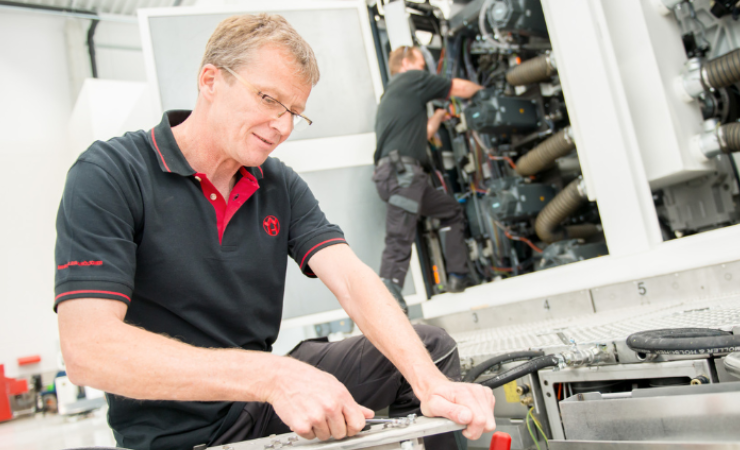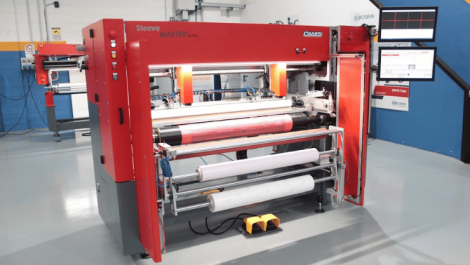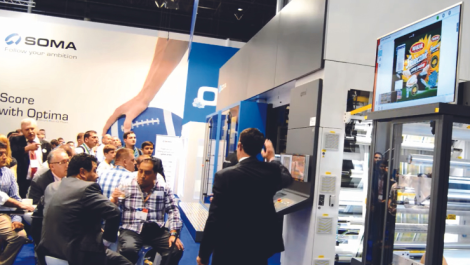From electrical components to major converting machinery, there is a great deal of potential for enhancing the performance of a flexo press already in the field.
The ability to extend the life or the capabilities of a printing press has become a signature of the flexographic printing and converting sector. New press installation announcements very often detail a range of added inline features and technologies, tailored to the print company’s requirements. Although the initial investment is obviously not a retrofit scenario, there is a clear line linking the modularity of modern flexo presses suggested by these customised installations, with the potential for future additions and upgrades.
The press manufacturers themselves seem to view retrofitting as both of those things: additions and upgrades. It is far more than just bolting a new print unit, laminator, diecutter or foiling unit to an inline press – although such retrofits are commonplace. It is also much more than integrating an inkjet bar to a flexo press, thereby creating a ‘hybrid’ press of sorts. Retrofitting also includes swapping old components within a press for new, hopefully extending the press’s lifetime and enhancing its performance. In particular, electronics are a key avenue for improving press performance retrospectively.
‘For us, all three approaches to retrofitting are important,’ says Gallus Group CEO Dario Urbinati. ‘With converters routinely keeping their presses for over 20 years, while they clearly acknowledge the benefits of various modern press advancements, they aren’t prepared to simply throw away perfectly good machines. This is where retrofitting comes in.’
It stands to reason that such an approach is much less capital intensive than buying a new press, but the decision to retrofit is often not just about giving an existing printing press greater longevity. According to Mark Andy sales manager Phil Baldwin, ‘Retrofits can breathe new life into older presses, but the main reason is normally because of new business or a change in the book of business. Aside from bringing in new work it can enable convertors to bring work in house they may have been farming out.’
The Bobst view is slightly different. It says that, most often, retrofits are used to address obsolescent components such as drives, controllers and HMIs: electronics, therefore. ‘The overarching benefit of retrofitting technology is the reduction of downtime and the implementation of preventive measures, essentially constituting effective risk management,’ says Graham Dolan, technical service manager for web fed technologies at Bobst UK & Ireland.
He continues, ‘Retrofitting is often seen as unrelated to productivity or quality improvements so, on paper, the ROI is less apparent. However, the inevitability of part failure underscores the necessity of proactive planning to minimise downtime and ensure a seamless operation.’
These kinds of ‘under the bonnet’ upgrades can also improve the energy efficiency of a press, adds Windmöller & Hölscher regional sales manager Simon Pollock, who says, ‘Retrofitting technology is a multifaceted strategy that not only postpones the need for new investments but also elevates the overall efficiency, reliability and adaptability of the equipment.’
Ready, willing and able
Whatever the reason for retrofitting, and whatever the technological specifics of the retrofit, flexo printers should be reassured to know that their press manufacturer is ready, willing and, most importantly, able to accommodate such requests. Key to that is the build of the modern flexo press itself.
Nick Hughes, managing director of Nilpeter UK, tells FlexoTech, ‘This has been factored in from birth. The design has always been modular, but with modern presses today, this is about plug and play.
He adds that the print units are machined identically, allowing them to be ‘dropped straight in’, while the modern electrical cabinets are ‘super-easy’ to link in. If the retrofit is adding print units, it’s easy to see how this might be a comparatively straightforward process. However, many retrofits have the potential to be rather more complicated and need more careful planning and execution.
‘We need to establish scope of supply, expectations and deliverability,’ Mr Hughes continues. ‘We need to involve our technical department from an early stage and define or be very clear about who is responsible at every stage. We need a very close relationship and clear lines.’
The process is meticulous, according to Bobst’s Graham Dolan, and increasingly begins when speaking to customers about a new press. ‘Our approach is to futureproof our machines, so retrofitting is factored into press design. The decision between investing in new machinery or opting for upgrades and retrofits over time is an important discussion to have. At Bobst, we collaborate with customers over a three-year programme, strategically replacing and upgrading parts, eventually aligning older machines with the performance of new counterparts.’
Gallus’s Dario Urbinati claims that concepts of modularity and upgradability of past and present presses are in the company’s DNA, making upgrades and retrofits easier to install. These kinds of discussions can take place at the point of a customer buying a new press, and Mr Urbinati says the company retains a wide portfolio of technologies, including in its Gallus Classics division for servicing older equipment, to ensure customer requirements can be met.
The decision to opt for a retrofit is driven by the recognition that it provides a mid-term solution, securing enhanced performance for a smaller investment, points out Simon Pollock of Windmöller & Hölscher. These kinds of enhancements can also be undertaken quickly. ‘One crucial factor in favour of retrofits is the significantly reduced machine downtime, compared to installing a completely new press,’ says Mr Pollock. The company has established a specialised department that focuses exclusively on retrofitting and customising solutions for customers.
It is also interesting to view the subject from the perspective of a manufacturer whose products are frequently retrofitted to flexo presses. Maxcess manufactures technology such as die-cutting and scoring systems through brands including Rotometrics and Tidland. Greg Wells, its technical sales manager for the Americas, observes that it is important to understand how a retrofit might impact on the existing machine’s set up and processes. ‘Some machines may not have easy access to the web path, changing or interfering with already established processes. It may also include additional software integration changes from which the OEM would need to be involved.’
Success and failure
Retrofitting is therefore something that is both eminently possible with modern technology, while also being a project that requires clear thinking and careful planning. What, then, are the keys to success and the potential pitfalls that exist around retrofitting machinery to flexo presses?
‘Good question,’ says Nilpeter’s Nick Hughes. ‘All parties need to buy into the project. There needs to be a very clear scope of supply agreed up front. It must be clear who is responsible for what, but usually all parties want to reach a defined result. Also, vision is important. Nilpeter has been asked to get involved in some very special applications, maybe only an embryo of a product, with no real idea how to produce it. You need vision and courage to enter such a project. Yes, there is an element of danger, but with determination, drive, and knowhow, it’s possible to make it through.’
Mark Andy’s Phil Baldwin says it is ‘always important to work with the machine supplier, as quite often drawings, new guarding, software, etc. is required’. He adds, ‘Many times, customers have tried to fit something themselves, quite often because it seems cheaper to buy direct, but then find they need a software revision or other issues like guarding or control inputs.’
‘The key to success is to ensure that you fully understand what the customer wants to achieve,’ says MPS Systems UK managing director Nick Tyrer, ‘not only in terms of the finished product but also in terms of machine production speed and waste factors. You must ensure that the customer understands what they can expect from the retrofit, and not allow the salesperson to overpromise just to get the order.’
The message from Bobst is one of positivity and proactivity, with Graham Dolan saying, ‘Our message to customers with retrofitting is that with the right team backing you, the benefits are enormous, and the pitfalls are few. Good retrofitting doesn’t just work around obsolescence but adds more value to the machine. We’re highly proactive on retrofitting because we believe it’s one of the core essential service functions that all machine manufacturers should be able to offer.’
Maxcess highlights the importance of ensuring that a proposed retrofit which improves performance on one aspect of a machine is not inadvertently rendered meaningless by lack of comparable performance on another aspect of the press, for example, drying being unable to keep up with a new running speed.
And finally, Dario Urbinati of Gallus identifies the importance of flexibility, with a supplier able to modify solutions according to needs at any given point and in all aspects, whether that means upgrades to electronics or the addition of converting units, screen printing units, and so on.
Being ready for the future is also important. ‘Retrofitting conventional systems with state-of-the-art, digital elements means we can equip customers to be a part of the smart, connected print ecosystem well into the future,’ he says, ‘providing them with the means to improve efficiency, productivity and business performance. Arguably, this is the greatest strength of retrofitted technologies for today’s labels and packaging market.’






